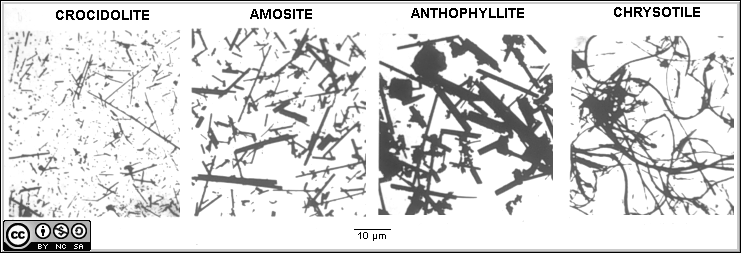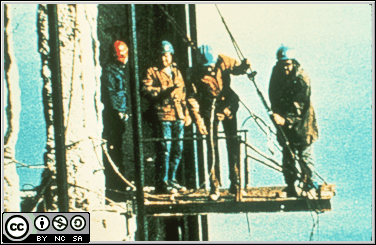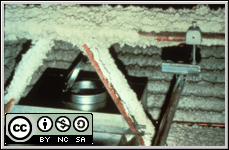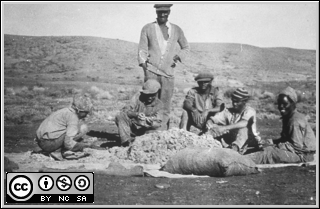 |
|||||||||||
| Module 4: Asbestos And Disease - Note |
CONTENTS:
- What is asbestos?
- A brief history of asbestos and disease;
- The asbestos related diseases;
- Fibre types, fibre levels and dose-response relationships.
- Disease impact in South Africa.
WHAT IS ASBESTOS?

Asbestos is a family of fibrous silicates, of which the most important commercially are crocidolite (blue asbestos), amosite (brown asbestos, from Asbestos Mines of South Africa) and chrysotile (white asbestos). The first two fall into the amphibole group, while chrysotile is an example of a serpentine mineral. (Slide 18) (Anthophyllite is not of commercial importance.)
All three were mined in South Africa (see SORDSA reading, p. 24, for map). About 95 percent of the fibre was exported. All of the South African mines are now closed, although chrysotile continues to be mined in Zimbabwe and Swaziland.

Asbestos was called the "magic mineral" because of its properties.  These include resistance to heat, acid, chemical and mechanical forces, the ability to be woven and spun (hence, asbestos textiles) and its ability to reinforce cement and plastic. It has had over 3000 uses, including insulation and fireproofing: e.g. around boilers, steam pipes, steel supports in building (see above picture - this building no longer exists - any ideas where it was?), inside air conditioning ducts (see picture on the right - not inside, but what’s wrong here?), asbestos cement (roofing slates, pipes, garden pots), other construction materials (ceilings, fascia boards), friction products (brakes, clutch pads) and domestic heaters.
These include resistance to heat, acid, chemical and mechanical forces, the ability to be woven and spun (hence, asbestos textiles) and its ability to reinforce cement and plastic. It has had over 3000 uses, including insulation and fireproofing: e.g. around boilers, steam pipes, steel supports in building (see above picture - this building no longer exists - any ideas where it was?), inside air conditioning ducts (see picture on the right - not inside, but what’s wrong here?), asbestos cement (roofing slates, pipes, garden pots), other construction materials (ceilings, fascia boards), friction products (brakes, clutch pads) and domestic heaters.
In South Africa, the major occupational exposures have been in asbestos mining and milling, insulation installation, repair and removal, asbestos cement product manufacture, brakes and pads manufacture and repair, textile manufacture and repair and many other smaller uses.
Besides those employed in asbestos product mining or manufacture, the following job titles should alert you to the possibility of asbestos exposure: workers associated with power stations, railway workshops and ship construction and repair ; boilermakers; steamfitters; electricians; roofers; motor vehicle mechanics; stevedores at harbours handling asbestos cargoes. There have been many more possibilities for "bystander" occupational exposure, such as welders operating in areas with asbestos insulation, and a probing history may be needed to identify possible asbestos exposure.
Consumer users of asbestos products such as housing and roofing, garden products, pottery kilns and domestic heaters are potentially exposed, but in the absence of sanding, sawing or cutting activities, these exposures are likely to be much lower than anything found in the occupational setting. The risk to these consumers and to occupants of houses and schools containing asbestos is extremely difficult to study and remains unknown.
However, many residents of asbestos mining areas have been exposed to environmental pollution (see picture above) and to asbestos used to construct roads, playgrounds and house bricks in these areas. The risk here has been established, specifically in the asbestos areas of the Northern Cape, where a very high risk of mesothelioma has been measured, and in the Limpopo Province (old Northeastern Transvaal) where a high prevalence of pleural disease has been documented. All of the asbestos related diseases have been found in association with purely "environmental" exposures in these settings.
 It has been estimated that assuming a mean duration of employment of about 7 years, something of the order of 200 000 workers may have been exposed to asbestos in mining and milling over a 50 year period in South Africa. This excludes the many local people who were engaged in small-scale or informal "cobbing" (see picture on the left) of asbestos from the ore or picking on the waste dumps around the mines (see pictures below). Smaller numbers were employed in the asbestos products industry - of the order of 30 000 over an equivalent period. An unknown number of others have been exposed in the many categories of asbestos use and in environmental exposure in asbestos mining areas.
It has been estimated that assuming a mean duration of employment of about 7 years, something of the order of 200 000 workers may have been exposed to asbestos in mining and milling over a 50 year period in South Africa. This excludes the many local people who were engaged in small-scale or informal "cobbing" (see picture on the left) of asbestos from the ore or picking on the waste dumps around the mines (see pictures below). Smaller numbers were employed in the asbestos products industry - of the order of 30 000 over an equivalent period. An unknown number of others have been exposed in the many categories of asbestos use and in environmental exposure in asbestos mining areas.

Postgraduate Diploma in Occupational Health (DOH) - Modules 3 – 5: Occupational Medicine & Toxicology by Prof Rodney Ehrlich & Prof Mohamed Jeebhay is licensed under a Creative Commons Attribution-NonCommercial-ShareAlike 3.0 Unported License.
Permissions beyond the scope of this license may be available at http://www.healthedu.uct.ac.za/